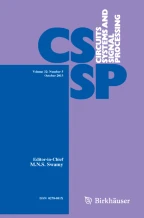Abstract
In order to fully exploit the scarce spectrum, antenna arrays are incorporated into wireless communication devices in 4G and 5G communication networks to deploy MIMO-OFDM systems. Recently, the least squares Khatri–Rao factorization has been applied to MIMO-OFDM systems for semi-blind joint channel and symbol estimation. Its cubic computational complexity is prohibitive when the number of transmit and receive antennas is very large. Therefore, the average vector and Hadamard ratio rank one approximation has been proposed for MIMO-OFDM systems, showing a linear complexity, but being limited to channels and transmitted symbols with offsets. In this paper, we present four novel MIMO-OFDM algorithms for massive antenna array systems that outperform the state-of-the-art approaches in terms of complexity and/or accuracy. The four proposed schemes are the alternating least squares with vector selection initialization, the vector projection rank one approximation including vector selection rank one initialization, the factorization based on eigenvalue decomposition with eigenvector projection and the factorization based on sectional truncated singular value decomposition and vector projection. Our analytical complexity analysis and numerical results corroborate the trade-offs offered by the different receiver algorithms in terms of complexity, parallelism and performance.
Similar content being viewed by others
Notes
A simple and suboptimal choice of \(\phi \) is given by \(\phi _m=2\pi (m-1)/M\). However, it can be optimized. See [24].
References
S. Alamouti, A simple transmit diversity technique for wireless communications. IEEE J. Sel. Areas Commun. 16, 1451–1458 (1998)
J.D. Carroll, J. Chang, Analysis of individual differences in multidimensional scaling via an \(n\)-way generalization of “Eckart–Young” decomposition. Psychometrika 35(3), 283–319 (1970)
A.L.F. de Almeida, G. Favier, J.C.M. Mota, PARAFAC-based unified tensor modeling for wireless communication systems with application to blind multiuser equalization. Sig. Process. 87, 337–351 (2007)
A.L.F. de Almeida, G. Favier, J.C.M. Mota, Space–time spreading-multiplexing for MIMO wireless communication systems using the PARATUCK2 tensor model. Sig. Process. 89(11), 2103–2116 (2009)
A.L.F. de Almeida, G. Favier, J.C.M. Mota, C.C. Cavalcante, Tensor-based space–time multiplexing codes for MIMO–OFDM systems with blind detection, in Proc. IEEE Symp. Pers. Ind. Mob. Radio Commun. (PIMRC) (Helsinki, Sept. 2006)
J.P.C.L. da Costa, A.L.F. de Almeida, W.C. Freitas, D.V. de Lima, Low complexity closed form solution to semi-blind joint channel and symbol estimation in MIMO–OFDM, in Proc. 19th International Conference on OFDM and Frequency Domain Techniques(ICOF 2016) (Essen, 2016)
J.P.C.L. da Costa, F. Roemer, M. Weis, M. Haardt, Robust R–D parameter estimation via closed-form PARAFAC, in Proc. ITG Workshop on Smart Antennas (WSA’10) (Bremen, 2010)
C. Desset, L.V. der Perre, Validation of low-accuracy quantization in massive MIMO and constellation EVM analysis, in Proc. 2015 European Conference on Networks and Communications (EuCNC) (2015)
A.B. Ericsson, Ericsson mobility report. Ericsson AB, Revision A, Stockholm, Sweden (Nov. 2016)
W.C. Freitas, A.L.F. de Almeida, J.P.C.L. da Costa, Blind Joint Channel Estimation and Data Detection for Precoded Multi-layered Space–Frequency MIMO Schemes. Circuits, Systems and Signal Processing (Elsevier, Amsterdam, 2013)
G.H. Golub, C.F.V. Loan, Matrix Computations, Fourth edn. (The Johns Hopkins University Press, Baltimore, 2013)
N. Halko, P. Martinsson, J.A. Tropp, Finding structure with randomness: stochastic algorithms for constructing approximate matrix decomposition. SIAM Rev. 53, 217–288 (2009)
R.A. Harshman, Foundations of the PARAFAC procedure: model and conditions for an “explanatory” multi-mode factor analysis. UCLA Working papers in phonetics, vol. 16(1) (1970)
H. Jedda, J.A. Nossek, A. Mezghani, Minimum BER precoding in 1-bit massive MIMO systems, in Proc. 2016 IEEE Sensor Array and Multichannel Signal Processing Workshop (SAM) (Rio de Janeiro, Sept 2016)
T.G. Kolda, B.W. Bader, Tensor decompositions and applications. Soc. Ind. Appl. Math. (SIAM) 51(3), 455–500 (2009)
K. Liu, J.P.C.L. da Costa, A.L.F. de Almeida, H.C. So, A closed form solution to semi-blind joint symbol and channel estimation in MIMO–OFDM systems, in Proc. 2012 IEEE International Conference on Signal Processing, Communications and Computing (ICSPCC’12) (Hong Kong, Aug. 2012)
K. Liu, J.P.C.L. da Costa, H.C. So, A.L.F. de Almeida, Semi-blind receivers for joint symbol and channel estimation in space-time-frequency diversity based MIMO-OFDM systems. IEEE Trans. Sig. Process. 61(21), 5444–5457 (2013)
F. Roemer, M. Haardt, Tensor-based channel estimation (TENCE) for two-way relaying with multiple antennas and spatial reuse, in Proc. IEEE Int. Conf. Acoustics, Speech and Sig. Proc. (ICASSP 2009) (Taipei, Apr. 2009)
F. Rusek, D. Persson, B.K. Lau, E.G. Larsson, T.L. Marzetta, O. Edfors, F. Tufvesson, Scaling up MIMO: opportunities and challenges with very large arrays. IEEE Sig. Process. Mag. 30(1), 40–60 (2013)
A.M. Sayeed, Deconstructing multiantenna fading channels. IEEE Trans. Sig. Process. 50(10), 2563–2579 (2002)
A.M. Sayeed, V. Raghavan, Maximizing MIMO capacity in sparse multipath with reconfigurable antenna arrays. IEEE J. Sel. Top. Sig. Process. 1(1), 156–166 (2007)
A. Smilde, R. Bro, P. Geladi, Multi-way Analysis: Applications in the Chemical Science (Wiley, London, 2004)
G.W. Stewart, Matrix Algorithms (Society for Industrial and Applied Mathematics (SIAM), Philadelphia, 1998)
Y. Xin, Z. Wang, G.B. Giannakis, Space–time diversity systems based on linear constellation precoding. IEEE Trans. Wirel. Commun. 2(2), 294–309 (2003)
Acknowledgements
The authors would like to thank the Research Support Foundation of the Brazilian Federal District (FAPDF) for their funding under the calls 03/2015 and 01/2017, the Brazilian Coordination for the Improvement of Higher Education Personnel (CAPES) for the PNPD, PVE and PDE scholarships, and CAPES/PROBAL Grant 88887.144009/2017-00. João P. C. L. da Costa and André L. F. de Almeida are partially supported by the Brazilian National Council for Scientific and Technological Development (CNPq).
Author information
Authors and Affiliations
Corresponding author
Rights and permissions
About this article
Cite this article
Kehrle Miranda, R., C. L. da Costa, J.P., Guo, B. et al. Low-Complexity and High-Accuracy Semi-blind Joint Channel and Symbol Estimation for Massive MIMO-OFDM. Circuits Syst Signal Process 38, 1114–1136 (2019). https://doi.org/10.1007/s00034-018-0898-1
Received:
Revised:
Accepted:
Published:
Issue Date:
DOI: https://doi.org/10.1007/s00034-018-0898-1
